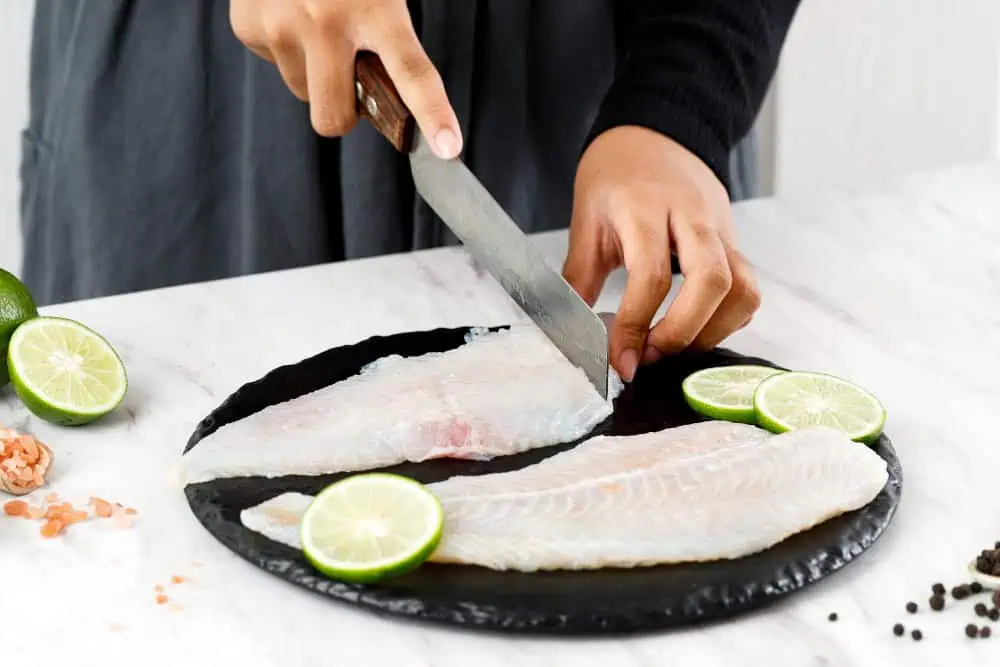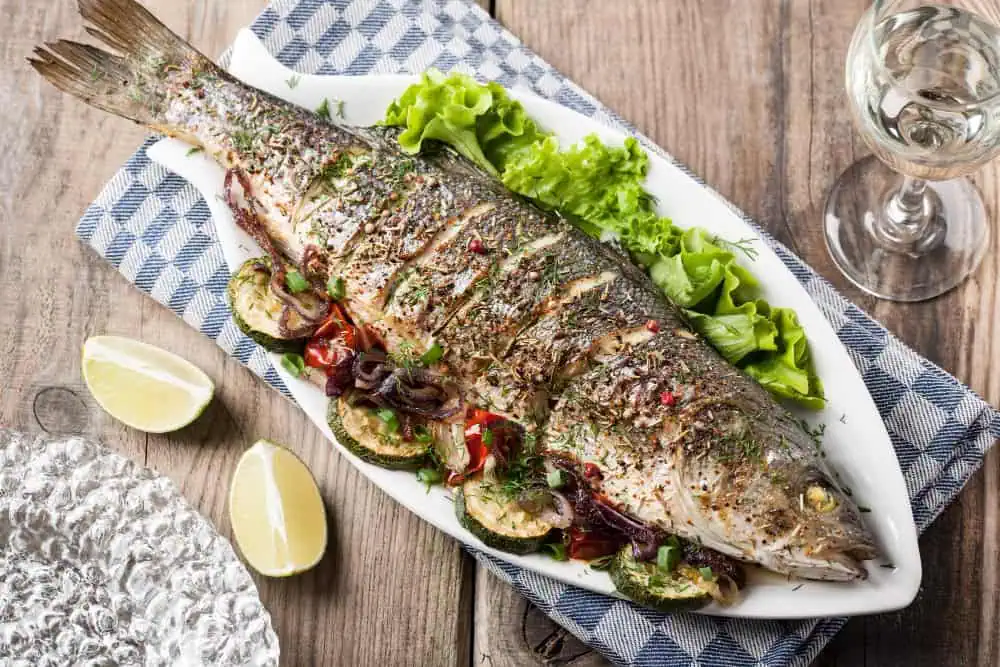When it comes to enjoying branzino, also known as European sea bass, many diners wonder: “do you eat the skin of branzino?” The simple answer is yes – the skin of branzino is not only edible but also delicious when prepared correctly. In this comprehensive guide, we’ll explore everything you need to know about enjoying this prized Mediterranean fish, including its skin.
Understanding Branzino and Its Skin
What is Branzino?
Branzino is a premium white fish that’s highly valued in Mediterranean cuisine. This elegant fish is known for its:
- Mild, delicate flavor: Branzino has a subtle taste that pairs well with various seasonings and sides.
- Light, flaky texture: The flesh is tender and flaky, making it a favorite among seafood lovers. Curious if branzino is a good choice for your diet? Find out everything you need to know about eating branzino.
- Silver-skinned appearance: Its shiny, silver skin is not only beautiful but also adds to the overall presentation of the dish.
- Lean, protein-rich meat: Branzino is a healthy choice, packed with high-quality protein and essential nutrients.
For a step-by-step guide on cooking and serving branzino, learn how to cook and eat branzino perfectly.
The Composition of Branzino Skin
The skin of branzino contains:
- Beneficial omega-3 fatty acids: These healthy fats are known for their heart health benefits.
- Collagen: Important for skin health and joint function.
- Essential minerals: Such as selenium and phosphorus, which are vital for various bodily functions.
- Protective scales: These should be removed before cooking to ensure a pleasant eating experience.
Learn more about what kind of fish branzino is and its origins.
Why You Should Consider Eating Branzino Skin
Nutritional Benefits
When you eat the skin of branzino, you’re getting:
- Extra protein: The skin contributes additional protein to your meal, enhancing its nutritional value.
- Healthy fats: Omega-3 fatty acids found in the skin support heart health and reduce inflammation.
- Important nutrients: The skin contains vitamins and minerals that are beneficial for overall health.
- Added texture to your meal: Crispy skin can elevate the dining experience, providing a delightful contrast to the tender flesh.
Culinary Advantages
The skin adds:
- Crispy texture when properly cooked: A well-cooked branzino skin can be incredibly crispy, adding a satisfying crunch to each bite.
- Enhanced flavor: The skin can absorb seasonings and flavors during cooking, enriching the overall taste of the dish.
- Natural moisture barrier: Cooking with the skin helps keep the fish moist and flavorful, preventing it from drying out.
- Additional depth to the dish: The skin can contribute to the overall complexity of flavors in your meal.
How to Prepare Branzino Skin for Eating
Proper Cleaning Techniques
Before cooking branzino with its skin, ensure you:
- Scale the fish thoroughly: Use a fish scaler or the back of a knife to remove the scales, working from the tail to the head.
- Rinse under cold water: This helps remove any remaining scales and debris.
- Pat dry completely: Use paper towels to dry the skin, which is crucial for achieving a crispy texture.
- Check for any remaining scales: Inspect the skin closely to ensure it’s clean and ready for cooking.
Best Cooking Methods for Crispy Skin
- Pan-Searing
- Heat a non-stick or cast-iron pan until very hot.
- Add a high-smoke-point oil, such as canola or grapeseed oil.
- Place the branzino skin-side down and press gently to ensure even contact with the pan.
- Cook for about 5-7 minutes until the skin is golden brown and crispy.
- Flip the fish and cook for an additional 3-5 minutes until the flesh is opaque.
- Grilling
- Preheat the grill to medium-high heat and ensure the grates are clean.
- Oil the grill grates to prevent sticking.
- Place the branzino skin-side up and grill for about 6-8 minutes.
- Carefully flip the fish and grill for another 4-5 minutes until cooked through.
- Baking
- Preheat the oven to 400°F (200°C).
- Place the branzino skin-side down on a baking sheet lined with parchment paper.
- Drizzle with olive oil and season with salt and pepper.
- Bake for 15-20 minutes or until the fish flakes easily with a fork.
- Broiling
- Preheat the broiler and place the oven rack about 6 inches from the heat source.
- Place the branzino on a broiler pan, skin-side up.
- Broil for 5-7 minutes, watching closely to avoid burning, until the skin is crispy and the flesh is opaque.

When Not to Eat Branzino Skin
Quality Indicators
Avoid eating the skin if:
- The fish isn’t fresh: Freshness is key to enjoying branzino skin. If the fish smells off or has a slimy texture, it’s best to avoid it.
- The skin appears damaged: If the skin is torn or has an unusual color, it may not be safe to eat.
- There’s excessive slime: A slimy texture can indicate spoilage.
- The scales haven’t been properly removed: Ensure the skin is clean and free of scales for the best eating experience.
Tips for Perfect Branzino Skin
Getting That Golden Crisp
To achieve perfectly crispy skin when you eat branzino:
- Ensure the skin is very dry: Moisture is the enemy of crispiness. Pat the skin dry with paper towels before cooking.
- Use the right amount of oil: A thin layer of oil helps achieve a crispy texture without making the fish greasy.
- Maintain proper heat: Cooking at the right temperature is crucial. Too low, and the skin won’t crisp; too high, and it may burn.
- Don’t move the fish too much while cooking: Allow the skin to sear properly before flipping to ensure it stays intact and crispy.
Seasoning for Flavor
Enhance the flavor of your branzino skin by:
- Rubbing with salt and pepper: A simple seasoning can elevate the taste significantly.
- Adding herbs like thyme or rosemary: Fresh herbs can infuse the fish with aromatic flavors.
- Drizzling with lemon juice or olive oil before cooking: This adds brightness and richness to the dish.
Serving Suggestions for Branzino with Skin
Traditional Mediterranean Style
Serve your branzino with crispy skin alongside:
- Lemon wedges: A squeeze of fresh lemon juice brightens the flavors.
- Fresh herbs: Parsley, dill, or basil can add a fresh touch.
- Extra virgin olive oil: Drizzling high-quality olive oil enhances the dish’s richness.
- Mediterranean vegetables: Roasted or grilled vegetables like zucchini, bell peppers, and eggplant complement the fish beautifully.
Creative Pairings
Consider pairing branzino with:
- Couscous or quinoa salad: These grains provide a hearty base and can be flavored with herbs and spices.
- Roasted potatoes: Crispy potatoes make a satisfying side dish.
- Grilled asparagus or zucchini: These vegetables add color and nutrition to your plate.
- A light white wine: Pair with a crisp Sauvignon Blanc or a fruity Pinot Grigio to enhance the dining experience.
FAQs About Eating Branzino Skin
Is branzino skin safe to eat?
Yes, branzino skin is completely safe to eat when the fish is properly cleaned and cooked. In fact, it’s a nutritious part of the fish that many consider a delicacy.
For a broader guide on eating fish skin, read about whether you should eat fish skin here.
Should you remove the skin from branzino?
No, there’s no need to remove the skin from branzino. The skin helps keep the fish moist during cooking and becomes deliciously crispy when prepared correctly.
How do you know if branzino is cooked properly?
Properly cooked branzino should:
- Have crispy, golden-brown skin: This indicates that the skin has been cooked correctly.
- Flake easily with a fork: The flesh should be tender and separate easily.
- Be opaque throughout: The fish should lose its translucent appearance.
- Reach an internal temperature of 145°F (63°C): Use a food thermometer to ensure it’s cooked safely.
Can you eat branzino raw?
While some fish can be eaten raw, branzino is typically served cooked. If you want to eat it raw, ensure it’s sushi-grade and properly frozen first to eliminate parasites.
What are the health benefits of eating branzino?
Branzino is rich in:
- Omega-3 fatty acids: Beneficial for heart health and reducing inflammation.
- High-quality protein: Essential for muscle repair and growth.
- Vitamins and minerals: Including B vitamins and selenium, which support various bodily functions.
Expert Tips for Branzino Preparation
Shopping for Quality Branzino
Look for:
- Clear, bright eyes: Indicates freshness.
- Firm flesh: Fresh fish should feel firm to the touch.
- Fresh, ocean-like smell: A clean, briny smell is a good sign.
- Shiny, intact scales: The skin should look vibrant and healthy.
- Red gills: Bright red gills indicate freshness.
Storage Recommendations
To maintain freshness:
- Keep refrigerated at 40°F (4°C) or below: Store branzino in the coldest part of your refrigerator.
- Use within 1-2 days of purchase: Fresh fish is best enjoyed soon after buying.
- Store on ice if possible: This helps keep the fish cold and fresh.
- Keep wrapped in paper, not plastic: Paper allows the fish to breathe and prevents it from becoming slimy.
The Environmental Impact of Branzino Fishing
Sustainability Considerations
When choosing branzino, consider:
- Sourcing from sustainable fisheries: Look for fish that are caught or farmed in environmentally responsible ways.
- Checking for certifications: Certifications like the Marine Stewardship Council (MSC) indicate sustainable practices.
- Being aware of overfishing issues: Some regions may have overfished branzino populations, so it’s essential to choose wisely.
Farmed vs. Wild-Caught Branzino
- Farmed Branzino: Generally more sustainable, but may have a different flavor and texture. Farmed fish can be raised in controlled environments, reducing the risk of contaminants.
- Wild-Caught Branzino: Often considered superior in taste, but be mindful of sustainability practices. Wild-caught fish may have a more robust flavor due to their natural diet.

Cooking Branzino: Recipes to Try
Simple Pan-Seared Branzino with Lemon and Herbs
Ingredients:
- 2 whole branzino, cleaned and scaled
- 2 tablespoons olive oil
- Salt and pepper to taste
- Fresh herbs (thyme, rosemary)
- Lemon wedges
Instructions:
- Pat the branzino dry and season with salt and pepper.
- Heat olive oil in a pan over medium-high heat.
- Place the branzino skin-side down and cook for 5-7 minutes.
- Flip and cook for another 5 minutes until the flesh is opaque.
- Serve with fresh herbs and lemon wedges.
Grilled Branzino with Garlic and Parsley
Ingredients:
- 2 whole branzino, cleaned and scaled
- 4 cloves garlic, minced
- 1/4 cup fresh parsley, chopped
- 2 tablespoons olive oil
- Salt and pepper to taste
Instructions:
- Preheat the grill to medium-high heat.
- In a bowl, mix garlic, parsley, olive oil, salt, and pepper.
- Rub the mixture inside the cavity of the branzino.
- Grill the fish skin-side down for 6-8 minutes, then flip and grill for another 4-5 minutes.
- Serve hot with a drizzle of olive oil.
Mediterranean Stuffed Branzino
Ingredients:
- 2 whole branzino, cleaned and scaled
- 1 cup cooked quinoa
- 1/2 cup cherry tomatoes, halved
- 1/4 cup Kalamata olives, pitted and chopped
- 1/4 cup feta cheese, crumbled
- 2 tablespoons olive oil
- Salt and pepper to taste
- Fresh basil for garnish
Instructions:
- Preheat the oven to 375°F (190°C).
- In a bowl, combine quinoa, cherry tomatoes, olives, feta, olive oil, salt, and pepper.
- Stuff the branzino with the quinoa mixture.
- Place the stuffed branzino on a baking sheet and drizzle with olive oil.
- Bake for 25-30 minutes until the fish is cooked through.
- Garnish with fresh basil before serving.
Branzino with Tomato and Olive Salsa
Ingredients:
- 2 whole branzino, cleaned and scaled
- 1 cup cherry tomatoes, diced
- 1/2 cup Kalamata olives, pitted and chopped
- 1/4 cup red onion, finely chopped
- 2 tablespoons capers, rinsed
- 2 tablespoons olive oil
- 1 tablespoon red wine vinegar
- Salt and pepper to taste
- Fresh basil for garnish
Instructions:
- Preheat the oven to 400°F (200°C).
- In a bowl, combine tomatoes, olives, onion, capers, olive oil, vinegar, salt, and pepper.
- Place the branzino on a baking sheet and top with the salsa mixture.
- Bake for 20-25 minutes until the fish is cooked through.
- Garnish with fresh basil before serving.
Looking for the perfect way to prepare branzino at home? Check out this delicious Mediterranean branzino recipe guide for flavorful inspiration.
Conclusion
So, do you eat the skin of branzino? Absolutely! When properly prepared, branzino skin adds both nutritional value and delicious texture to your meal. Whether you’re cooking this Mediterranean favorite at home or ordering it at a restaurant, don’t shy away from enjoying the crispy, flavorful skin. Remember that the key to delicious branzino skin lies in proper preparation and cooking techniques. With the information provided in this guide, you’re now equipped to make the most of this delectable fish, skin and all.
Embrace the whole fish, including its skin, to enhance your culinary adventure with this beloved Mediterranean delicacy. By following the tips and recipes outlined in this article, you can enjoy branzino in a variety of delicious ways, ensuring that every bite is a celebration of flavor and nutrition.
Final Thoughts
As you explore the world of branzino, consider experimenting with different cooking methods and flavor profiles. The versatility of this fish allows for endless culinary creativity. Whether you prefer it grilled, baked, or pan-seared, branzino is sure to impress your family and friends. So, the next time you find yourself with this exquisite fish, remember to savor every part, including the skin, for a truly delightful dining experience.

